ESP Abarth 124 Spider 2021 Owner handbook (in English)
[x] Cancel search | Manufacturer: ABARTH, Model Year: 2021, Model line: 124 Spider, Model: Abarth 124 Spider 2021Pages: 224, PDF Size: 3.9 MB
Page 4 of 224
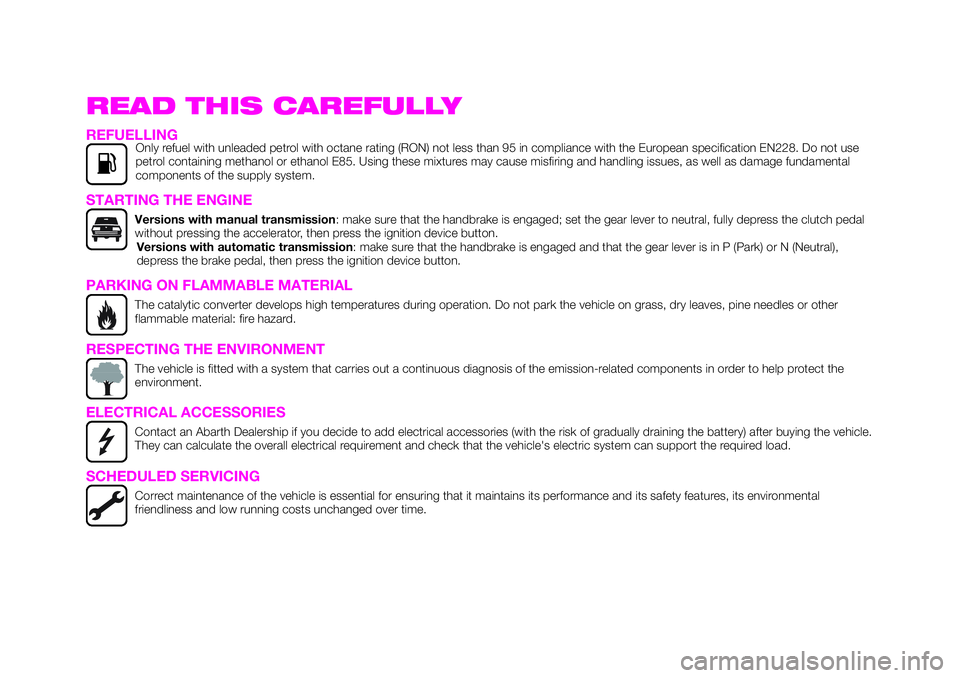
READ THIS CAREFULLY
REFUELLINGOnly refuel with unleaded petrol with octane rating (RON) not less than 95 in compliance with the European specification EN228. Do not use
petrol containing methanol or ethanol E85. Using these mixtures may cause misfiring and handling issues, as well as damage fundamental
components of the supply system.
STARTING THE ENGINE
Versions with manual transmission: make sure that the handbrake is engaged; set the gear lever to neutral, fully depress the clutch pedal
without pressing the accelerator, then press the ignition device button.
Versions with automatic transmission: make sure that the handbrake is engaged and that the gear lever is in P (Park) or N (Neutral),
depress the brake pedal, then press the ignition device button.
PARKING ON FLAMMABLE MATERIAL
The catalytic converter develops high temperatures during operation. Do not park the vehicle on grass, dry leaves, pine needles or other
flammable material: fire hazard.
RESPECTING THE ENVIRONMENT
The vehicle is fitted with a system that carries out a continuous diagnosis of the emission-related components in order to help protect the
environment.
ELECTRICAL ACCESSORIES
Contact an Abarth Dealership if you decide to add electrical accessories (with the risk of gradually draining the battery) after buying the vehicle.
They can calculate the overall electrical requirement and check that the vehicle's electric system can support the required load.
SCHEDULED SERVICING
Correct maintenance of the vehicle is essential for ensuring that it maintains its performance and its safety features, its environmental
friendliness and low running costs unchanged over time.
Page 5 of 224
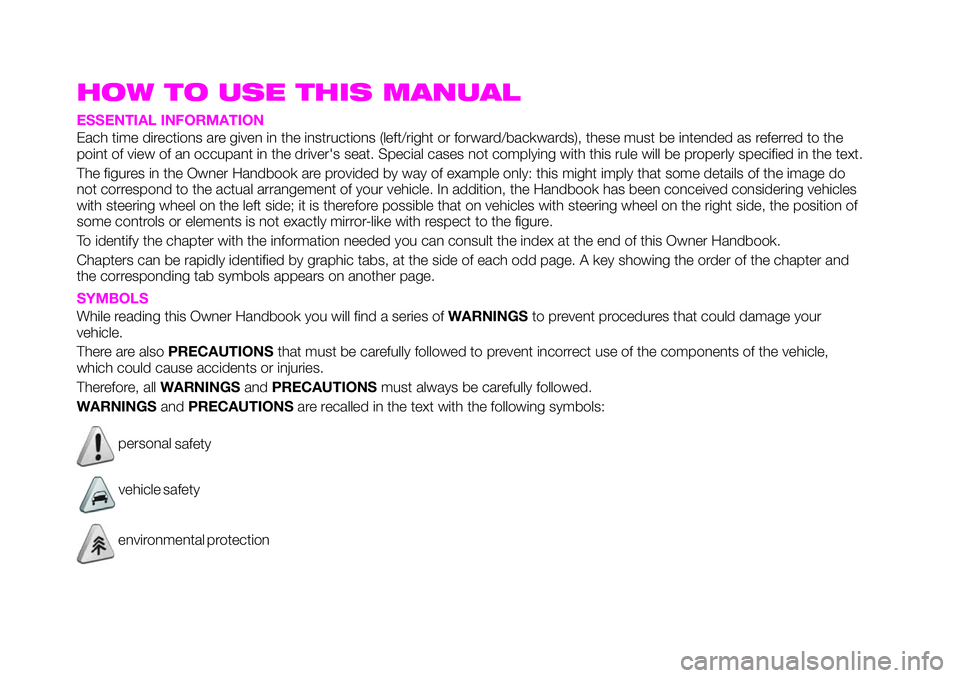
HOW TO USE THIS MANUAL
ESSENTIAL INFORMATION
Each time directions are given in the instructions (left/right or forward/backwards), these must be intended as referred to the
point of view of an occupant in the driver's seat. Special cases not complying with this rule will be properly specified in the text.
The figures in the Owner Handbook are provided by way of example only: this might imply that some details of the image do
not correspond to the actual arrangement of your vehicle. In addition, the Handbook has been conceived considering vehicles
with steering wheel on the left side; it is therefore possible that on vehicles with steering wheel on the right side, the position of
some controls or elements is not exactly mirror-like with respect to the figure.
To identify the chapter with the information needed you can consult the index at the end of this Owner Handbook.
Chapters can be rapidly identified by graphic tabs, at the side of each odd page. A key showing the order of the chapter and
the corresponding tab symbols appears on another page.
SYMBOLS
While reading this Owner Handbook you will find a series ofWARNINGSto prevent procedures that could damage your
vehicle.
There are alsoPRECAUTIONSthat must be carefully followed to prevent incorrect use of the components of the vehicle,
which could cause accidents or injuries.
Therefore, allWARNINGSandPRECAUTIONSmust always be carefully followed.
WARNINGSandPRECAUTIONSare recalled in the text with the following symbols:
personal
safety
vehicle
safety
environmentalprotection
Page 17 of 224
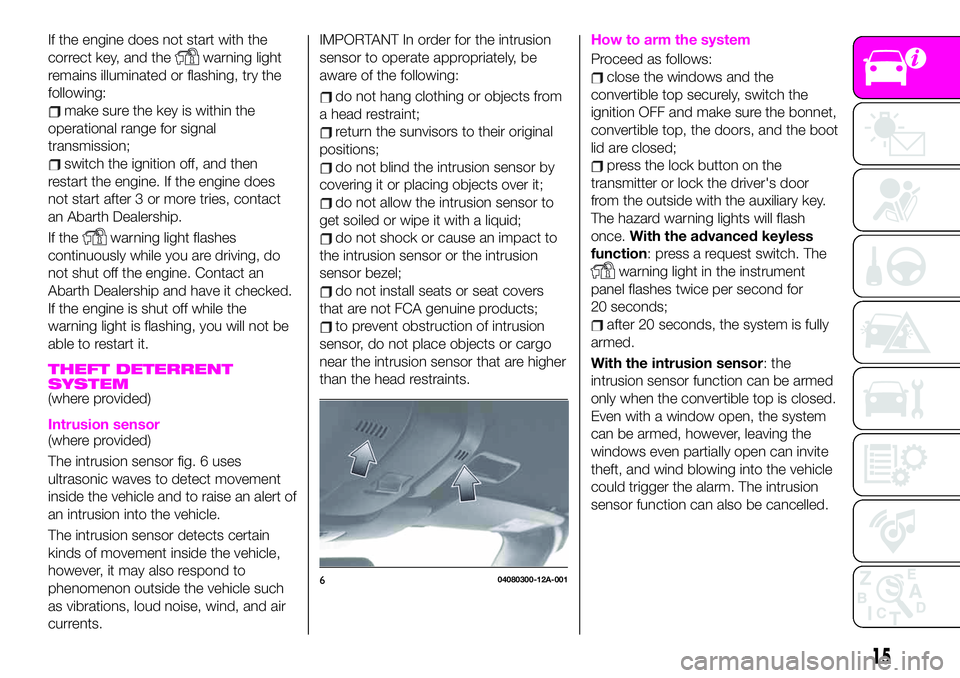
If the engine does not start with the
correct key, and the
warning light
remains illuminated or flashing, try the
following:
make sure the key is within the
operational range for signal
transmission;
switch the ignition off, and then
restart the engine. If the engine does
not start after 3 or more tries, contact
an Abarth Dealership.
If the
warning light flashes
continuously while you are driving, do
not shut off the engine. Contact an
Abarth Dealership and have it checked.
If the engine is shut off while the
warning light is flashing, you will not be
able to restart it.
THEFT DETERRENT
SYSTEM
(where provided)
Intrusion sensor(where provided)
The intrusion sensor fig. 6 uses
ultrasonic waves to detect movement
inside the vehicle and to raise an alert of
an intrusion into the vehicle.
The intrusion sensor detects certain
kinds of movement inside the vehicle,
however, it may also respond to
phenomenon outside the vehicle such
as vibrations, loud noise, wind, and air
currents.
IMPORTANT In order for the intrusion
sensor to operate appropriately, be
aware of the following:
do not hang clothing or objects from
a head restraint;
return the sunvisors to their original
positions;
do not blind the intrusion sensor by
covering it or placing objects over it;
do not allow the intrusion sensor to
get soiled or wipe it with a liquid;
do not shock or cause an impact to
the intrusion sensor or the intrusion
sensor bezel;
do not install seats or seat covers
that are not FCA genuine products;
to prevent obstruction of intrusion
sensor, do not place objects or cargo
near the intrusion sensor that are higher
than the head restraints.
How to arm the system
Proceed as follows:
close the windows and the
convertible top securely, switch the
ignition OFF and make sure the bonnet,
convertible top, the doors, and the boot
lid are closed;
press the lock button on the
transmitter or lock the driver's door
from the outside with the auxiliary key.
The hazard warning lights will flash
once.With the advanced keyless
function: press a request switch. The
warning light in the instrument
panel flashes twice per second for
20 seconds;
after 20 seconds, the system is fully
armed.
With the intrusion sensor: the
intrusion sensor function can be armed
only when the convertible top is closed.
Even with a window open, the system
can be armed, however, leaving the
windows even partially open can invite
theft, and wind blowing into the vehicle
could trigger the alarm. The intrusion
sensor function can also be cancelled.
604080300-12A-001
15
Page 20 of 224
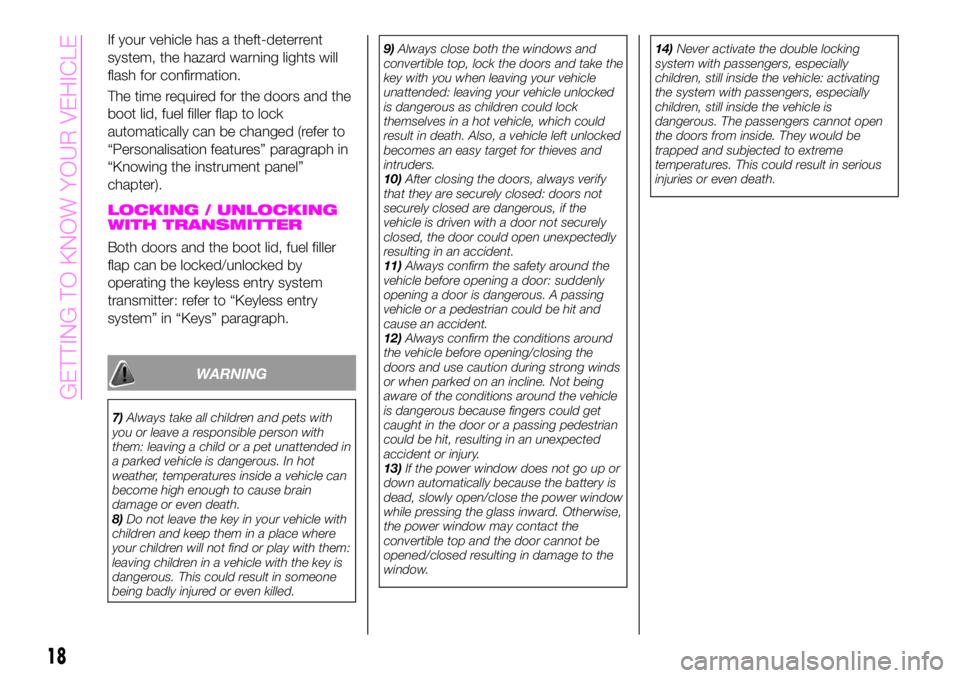
If your vehicle has a theft-deterrent
system, the hazard warning lights will
flash for confirmation.
The time required for the doors and the
boot lid, fuel filler flap to lock
automatically can be changed (refer to
“Personalisation features” paragraph in
“Knowing the instrument panel”
chapter).
LOCKING / UNLOCKING
WITH TRANSMITTER
Both doors and the boot lid, fuel filler
flap can be locked/unlocked by
operating the keyless entry system
transmitter: refer to “Keyless entry
system” in “Keys” paragraph.
WARNING
7)Always take all children and pets with
you or leave a responsible person with
them: leaving a child or a pet unattended in
a parked vehicle is dangerous. In hot
weather, temperatures inside a vehicle can
become high enough to cause brain
damage or even death.
8)Do not leave the key in your vehicle with
children and keep them in a place where
your children will not find or play with them:
leaving children in a vehicle with the key is
dangerous. This could result in someone
being badly injured or even killed.9)Always close both the windows and
convertible top, lock the doors and take the
key with you when leaving your vehicle
unattended: leaving your vehicle unlocked
is dangerous as children could lock
themselves in a hot vehicle, which could
result in death. Also, a vehicle left unlocked
becomes an easy target for thieves and
intruders.
10)After closing the doors, always verify
that they are securely closed: doors not
securely closed are dangerous, if the
vehicle is driven with a door not securely
closed, the door could open unexpectedly
resulting in an accident.
11)Always confirm the safety around the
vehicle before opening a door: suddenly
opening a door is dangerous. A passing
vehicle or a pedestrian could be hit and
cause an accident.
12)Always confirm the conditions around
the vehicle before opening/closing the
doors and use caution during strong winds
or when parked on an incline. Not being
aware of the conditions around the vehicle
is dangerous because fingers could get
caught in the door or a passing pedestrian
could be hit, resulting in an unexpected
accident or injury.
13)If the power window does not go up or
down automatically because the battery is
dead, slowly open/close the power window
while pressing the glass inward. Otherwise,
the power window may contact the
convertible top and the door cannot be
opened/closed resulting in damage to the
window.14)Never activate the double locking
system with passengers, especially
children, still inside the vehicle: activating
the system with passengers, especially
children, still inside the vehicle is
dangerous. The passengers cannot open
the doors from inside. They would be
trapped and subjected to extreme
temperatures. This could result in serious
injuries or even death.
18
GETTING TO KNOW YOUR VEHICLE
Page 31 of 224
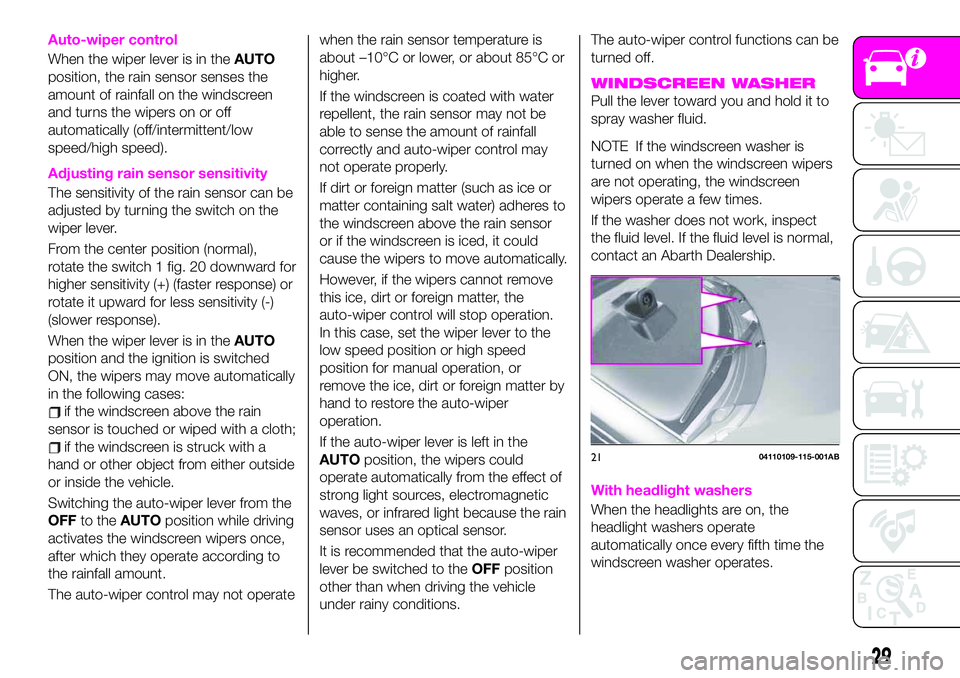
Auto-wiper control
When the wiper lever is in theAUTO
position, the rain sensor senses the
amount of rainfall on the windscreen
and turns the wipers on or off
automatically (off/intermittent/low
speed/high speed).
Adjusting rain sensor sensitivity
The sensitivity of the rain sensor can be
adjusted by turning the switch on the
wiper lever.
From the center position (normal),
rotate the switch 1 fig. 20 downward for
higher sensitivity (+) (faster response) or
rotate it upward for less sensitivity (-)
(slower response).
When the wiper lever is in theAUTO
position and the ignition is switched
ON, the wipers may move automatically
in the following cases:
if the windscreen above the rain
sensor is touched or wiped with a cloth;
if the windscreen is struck with a
hand or other object from either outside
or inside the vehicle.
Switching the auto-wiper lever from the
OFFto theAUTOposition while driving
activates the windscreen wipers once,
after which they operate according to
the rainfall amount.
The auto-wiper control may not operatewhen the rain sensor temperature is
about –10°C or lower, or about 85°C or
higher.
If the windscreen is coated with water
repellent, the rain sensor may not be
able to sense the amount of rainfall
correctly and auto-wiper control may
not operate properly.
If dirt or foreign matter (such as ice or
matter containing salt water) adheres to
the windscreen above the rain sensor
or if the windscreen is iced, it could
cause the wipers to move automatically.
However, if the wipers cannot remove
this ice, dirt or foreign matter, the
auto-wiper control will stop operation.
In this case, set the wiper lever to the
low speed position or high speed
position for manual operation, or
remove the ice, dirt or foreign matter by
hand to restore the auto-wiper
operation.
If the auto-wiper lever is left in the
AUTOposition, the wipers could
operate automatically from the effect of
strong light sources, electromagnetic
waves, or infrared light because the rain
sensor uses an optical sensor.
It is recommended that the auto-wiper
lever be switched to theOFFposition
other than when driving the vehicle
under rainy conditions.The auto-wiper control functions can be
turned off.
WINDSCREEN WASHER
Pull the lever toward you and hold it to
spray washer fluid.
NOTE If the windscreen washer is
turned on when the windscreen wipers
are not operating, the windscreen
wipers operate a few times.
If the washer does not work, inspect
the fluid level. If the fluid level is normal,
contact an Abarth Dealership.
With headlight washers
When the headlights are on, the
headlight washers operate
automatically once every fifth time the
windscreen washer operates.
2104110109-115-001AB
29
Page 39 of 224
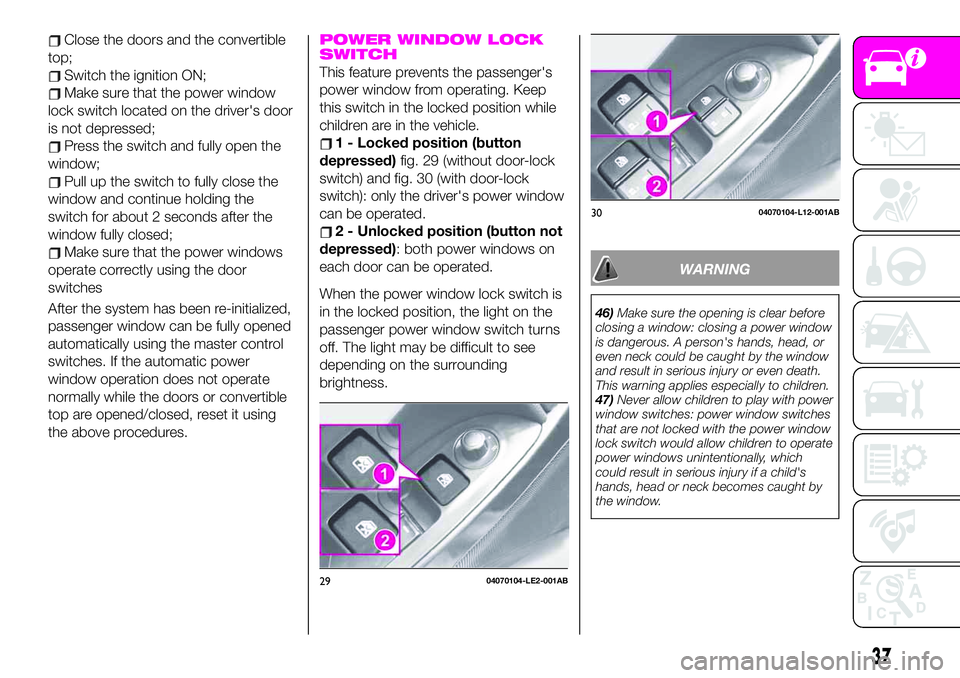
Close the doors and the convertible
top;
Switch the ignition ON;
Make sure that the power window
lock switch located on the driver's door
is not depressed;
Press the switch and fully open the
window;
Pull up the switch to fully close the
window and continue holding the
switch for about 2 seconds after the
window fully closed;
Make sure that the power windows
operate correctly using the door
switches
After the system has been re-initialized,
passenger window can be fully opened
automatically using the master control
switches. If the automatic power
window operation does not operate
normally while the doors or convertible
top are opened/closed, reset it using
the above procedures.
POWER WINDOW LOCK
SWITCH
This feature prevents the passenger's
power window from operating. Keep
this switch in the locked position while
children are in the vehicle.
1 - Locked position (button
depressed)fig. 29 (without door-lock
switch) and fig. 30 (with door-lock
switch): only the driver's power window
can be operated.
2 - Unlocked position (button not
depressed): both power windows on
each door can be operated.
When the power window lock switch is
in the locked position, the light on the
passenger power window switch turns
off. The light may be difficult to see
depending on the surrounding
brightness.
WARNING
46)Make sure the opening is clear before
closing a window: closing a power window
is dangerous. A person's hands, head, or
even neck could be caught by the window
and result in serious injury or even death.
This warning applies especially to children.
47)Never allow children to play with power
window switches: power window switches
that are not locked with the power window
lock switch would allow children to operate
power windows unintentionally, which
could result in serious injury if a child's
hands, head or neck becomes caught by
the window.
2904070104-LE2-001AB
3004070104-L12-001AB
37
Page 41 of 224
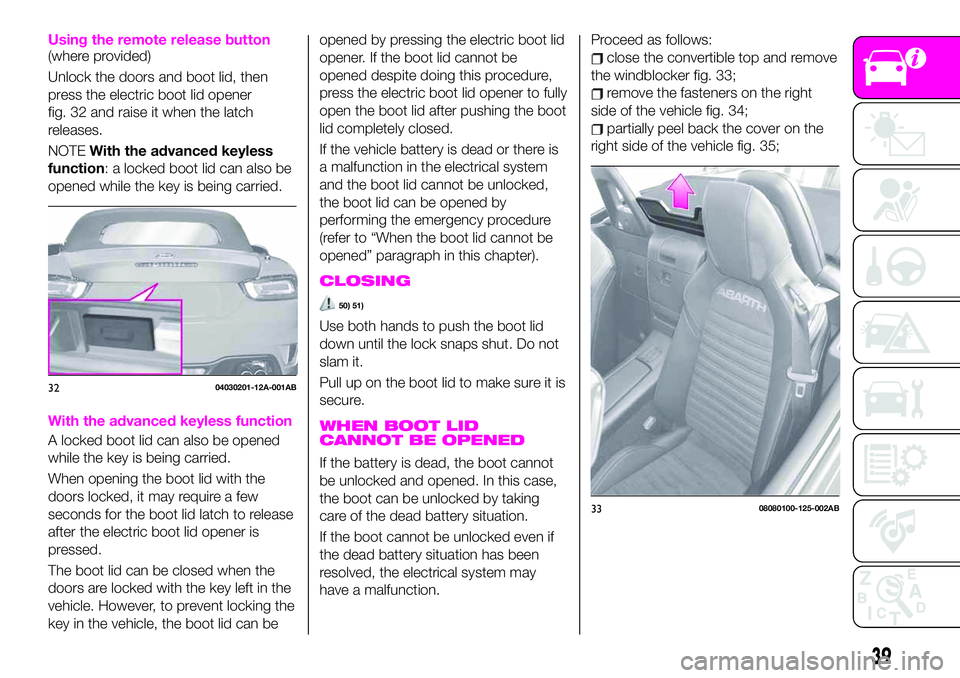
Using the remote release button(where provided)
Unlock the doors and boot lid, then
press the electric boot lid opener
fig. 32 and raise it when the latch
releases.
NOTEWith the advanced keyless
function: a locked boot lid can also be
opened while the key is being carried.
With the advanced keyless function
A locked boot lid can also be opened
while the key is being carried.
When opening the boot lid with the
doors locked, it may require a few
seconds for the boot lid latch to release
after the electric boot lid opener is
pressed.
The boot lid can be closed when the
doors are locked with the key left in the
vehicle. However, to prevent locking the
key in the vehicle, the boot lid can beopened by pressing the electric boot lid
opener. If the boot lid cannot be
opened despite doing this procedure,
press the electric boot lid opener to fully
open the boot lid after pushing the boot
lid completely closed.
If the vehicle battery is dead or there is
a malfunction in the electrical system
and the boot lid cannot be unlocked,
the boot lid can be opened by
performing the emergency procedure
(refer to “When the boot lid cannot be
opened” paragraph in this chapter).
CLOSING
50) 51)
Use both hands to push the boot lid
down until the lock snaps shut. Do not
slam it.
Pull up on the boot lid to make sure it is
secure.
WHEN BOOT LID
CANNOT BE OPENED
If the battery is dead, the boot cannot
be unlocked and opened. In this case,
the boot can be unlocked by taking
care of the dead battery situation.
If the boot cannot be unlocked even if
the dead battery situation has been
resolved, the electrical system may
have a malfunction.Proceed as follows:
close the convertible top and remove
the windblocker fig. 33;
remove the fasteners on the right
side of the vehicle fig. 34;
partially peel back the cover on the
right side of the vehicle fig. 35;
3204030201-12A-001AB
3308080100-125-002AB
39
Page 54 of 224
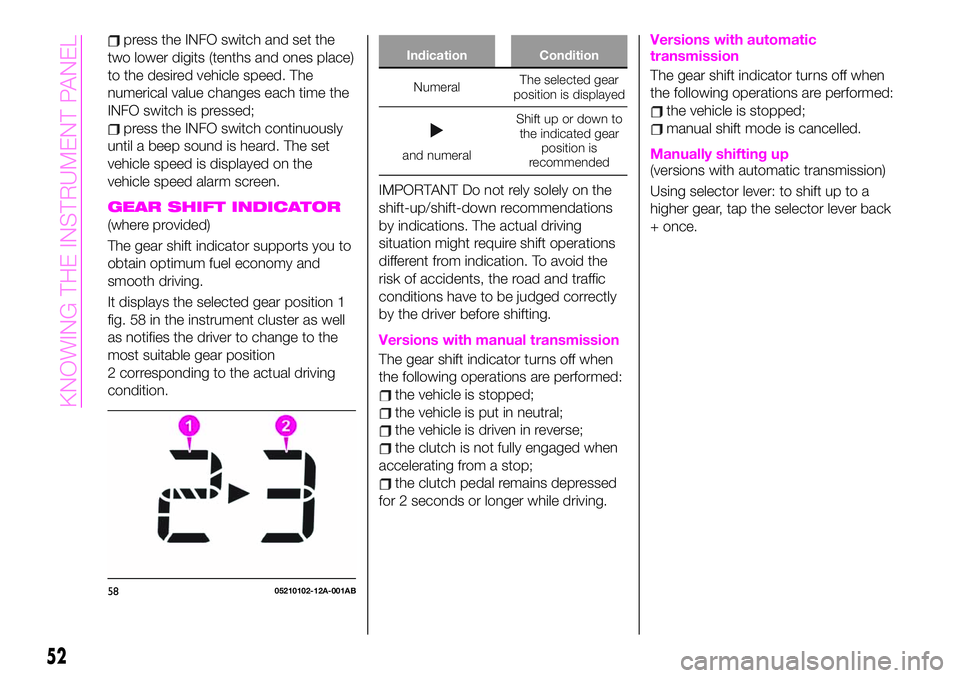
press the INFO switch and set the
two lower digits (tenths and ones place)
to the desired vehicle speed. The
numerical value changes each time the
INFO switch is pressed;
press the INFO switch continuously
until a beep sound is heard. The set
vehicle speed is displayed on the
vehicle speed alarm screen.
GEAR SHIFT INDICATOR
(where provided)
The gear shift indicator supports you to
obtain optimum fuel economy and
smooth driving.
It displays the selected gear position 1
fig. 58 in the instrument cluster as well
as notifies the driver to change to the
most suitable gear position
2 corresponding to the actual driving
condition.
Indication Condition
NumeralThe selected gear
position is displayed
and numeralShift up or down to
the indicated gear
position is
recommended
IMPORTANT Do not rely solely on the
shift-up/shift-down recommendations
by indications. The actual driving
situation might require shift operations
different from indication. To avoid the
risk of accidents, the road and traffic
conditions have to be judged correctly
by the driver before shifting.
Versions with manual transmission
The gear shift indicator turns off when
the following operations are performed:
the vehicle is stopped;
the vehicle is put in neutral;
the vehicle is driven in reverse;
the clutch is not fully engaged when
accelerating from a stop;
the clutch pedal remains depressed
for 2 seconds or longer while driving.
Versions with automatic
transmission
The gear shift indicator turns off when
the following operations are performed:
the vehicle is stopped;
manual shift mode is cancelled.
Manually shifting up(versions with automatic transmission)
Using selector lever: to shift up to a
higher gear, tap the selector lever back
+ once.
5805210102-12A-001AB
52
KNOWING THE INSTRUMENT PANEL
Page 75 of 224
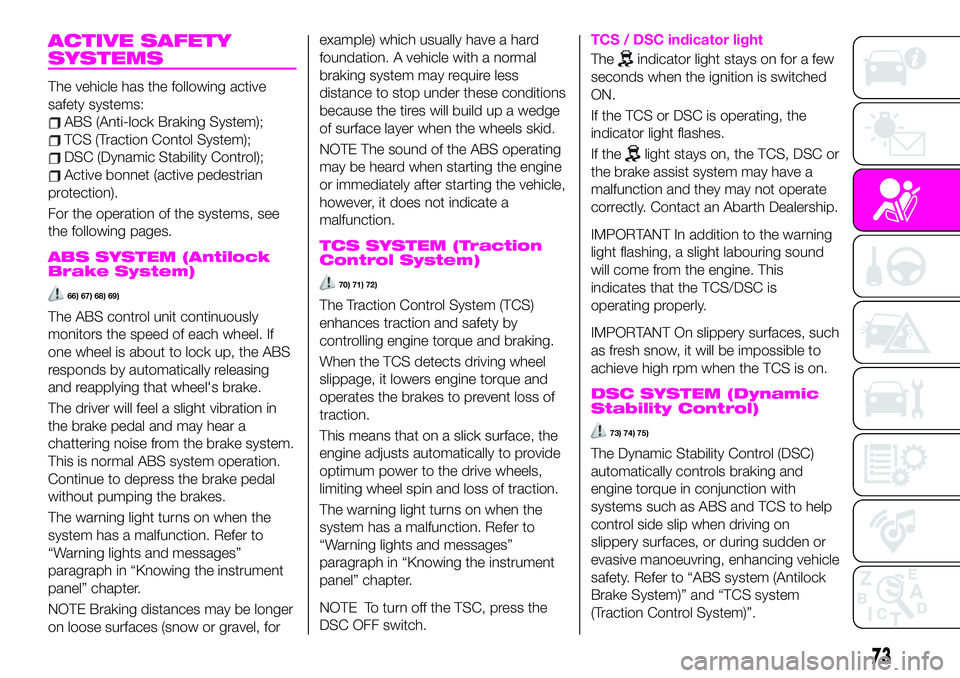
ACTIVE SAFETY
SYSTEMS
The vehicle has the following active
safety systems:
ABS (Anti-lock Braking System);
TCS (Traction Contol System);
DSC (Dynamic Stability Control);
Active bonnet (active pedestrian
protection).
For the operation of the systems, see
the following pages.
ABS SYSTEM (Antilock
Brake System)
66) 67) 68) 69)
The ABS control unit continuously
monitors the speed of each wheel. If
one wheel is about to lock up, the ABS
responds by automatically releasing
and reapplying that wheel's brake.
The driver will feel a slight vibration in
the brake pedal and may hear a
chattering noise from the brake system.
This is normal ABS system operation.
Continue to depress the brake pedal
without pumping the brakes.
The warning light turns on when the
system has a malfunction. Refer to
“Warning lights and messages”
paragraph in “Knowing the instrument
panel” chapter.
NOTE Braking distances may be longer
on loose surfaces (snow or gravel, forexample) which usually have a hard
foundation. A vehicle with a normal
braking system may require less
distance to stop under these conditions
because the tires will build up a wedge
of surface layer when the wheels skid.
NOTE The sound of the ABS operating
may be heard when starting the engine
or immediately after starting the vehicle,
however, it does not indicate a
malfunction.
TCS SYSTEM (Traction
Control System)
70) 71) 72)
The Traction Control System (TCS)
enhances traction and safety by
controlling engine torque and braking.
When the TCS detects driving wheel
slippage, it lowers engine torque and
operates the brakes to prevent loss of
traction.
This means that on a slick surface, the
engine adjusts automatically to provide
optimum power to the drive wheels,
limiting wheel spin and loss of traction.
The warning light turns on when the
system has a malfunction. Refer to
“Warning lights and messages”
paragraph in “Knowing the instrument
panel” chapter.
NOTE To turn off the TSC, press the
DSC OFF switch.
TCS / DSC indicator light
Theindicator light stays on for a few
seconds when the ignition is switched
ON.
If the TCS or DSC is operating, the
indicator light flashes.
If the
light stays on, the TCS, DSC or
the brake assist system may have a
malfunction and they may not operate
correctly. Contact an Abarth Dealership.
IMPORTANT In addition to the warning
light flashing, a slight labouring sound
will come from the engine. This
indicates that the TCS/DSC is
operating properly.
IMPORTANT On slippery surfaces, such
as fresh snow, it will be impossible to
achieve high rpm when the TCS is on.
DSC SYSTEM (Dynamic
Stability Control)
73) 74) 75)
The Dynamic Stability Control (DSC)
automatically controls braking and
engine torque in conjunction with
systems such as ABS and TCS to help
control side slip when driving on
slippery surfaces, or during sudden or
evasive manoeuvring, enhancing vehicle
safety. Refer to “ABS system (Antilock
Brake System)” and “TCS system
(Traction Control System)”.
73
Page 78 of 224
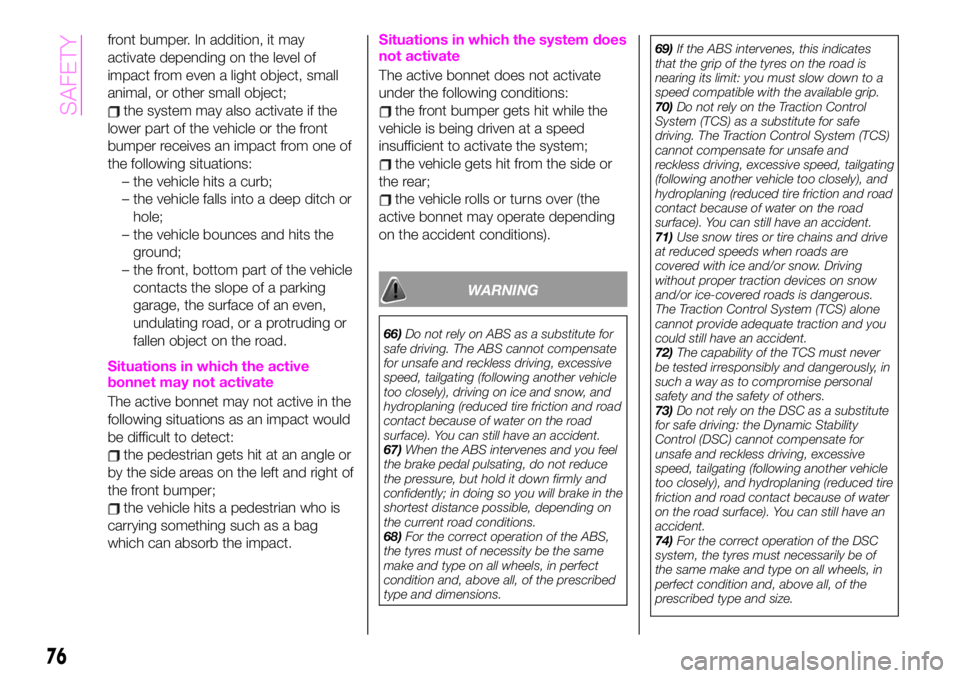
front bumper. In addition, it may
activate depending on the level of
impact from even a light object, small
animal, or other small object;
the system may also activate if the
lower part of the vehicle or the front
bumper receives an impact from one of
the following situations:
– the vehicle hits a curb;
– the vehicle falls into a deep ditch or
hole;
– the vehicle bounces and hits the
ground;
– the front, bottom part of the vehicle
contacts the slope of a parking
garage, the surface of an even,
undulating road, or a protruding or
fallen object on the road.
Situations in which the active
bonnet may not activate
The active bonnet may not active in the
following situations as an impact would
be difficult to detect:
the pedestrian gets hit at an angle or
by the side areas on the left and right of
the front bumper;
the vehicle hits a pedestrian who is
carrying something such as a bag
which can absorb the impact.
Situations in which the system does
not activate
The active bonnet does not activate
under the following conditions:
the front bumper gets hit while the
vehicle is being driven at a speed
insufficient to activate the system;
the vehicle gets hit from the side or
the rear;
the vehicle rolls or turns over (the
active bonnet may operate depending
on the accident conditions).
WARNING
66)Do not rely on ABS as a substitute for
safe driving. The ABS cannot compensate
for unsafe and reckless driving, excessive
speed, tailgating (following another vehicle
too closely), driving on ice and snow, and
hydroplaning (reduced tire friction and road
contact because of water on the road
surface). You can still have an accident.
67)When the ABS intervenes and you feel
the brake pedal pulsating, do not reduce
the pressure, but hold it down firmly and
confidently; in doing so you will brake in the
shortest distance possible, depending on
the current road conditions.
68)For the correct operation of the ABS,
the tyres must of necessity be the same
make and type on all wheels, in perfect
condition and, above all, of the prescribed
type and dimensions.69)If the ABS intervenes, this indicates
that the grip of the tyres on the road is
nearing its limit: you must slow down to a
speed compatible with the available grip.
70)Do not rely on the Traction Control
System (TCS) as a substitute for safe
driving. The Traction Control System (TCS)
cannot compensate for unsafe and
reckless driving, excessive speed, tailgating
(following another vehicle too closely), and
hydroplaning (reduced tire friction and road
contact because of water on the road
surface). You can still have an accident.
71)Use snow tires or tire chains and drive
at reduced speeds when roads are
covered with ice and/or snow. Driving
without proper traction devices on snow
and/or ice-covered roads is dangerous.
The Traction Control System (TCS) alone
cannot provide adequate traction and you
could still have an accident.
72)The capability of the TCS must never
be tested irresponsibly and dangerously, in
such a way as to compromise personal
safety and the safety of others.
73)Do not rely on the DSC as a substitute
for safe driving: the Dynamic Stability
Control (DSC) cannot compensate for
unsafe and reckless driving, excessive
speed, tailgating (following another vehicle
too closely), and hydroplaning (reduced tire
friction and road contact because of water
on the road surface). You can still have an
accident.
74)For the correct operation of the DSC
system, the tyres must necessarily be of
the same make and type on all wheels, in
perfect condition and, above all, of the
prescribed type and size.
76
SAFETY